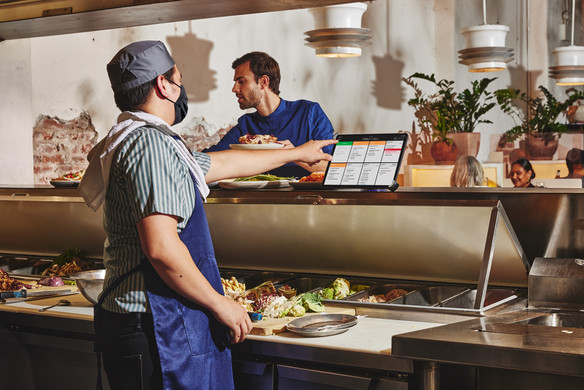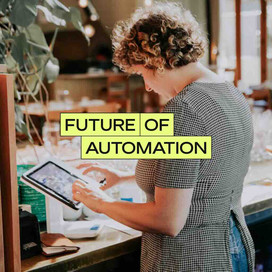Table of contents
From ordering and inventory management to assisting your line cooks with critical tasks, automated systems are already a part of many restaurant operation processes. In fact, the Square 2024 Future of Restaurants report found that more than half (54%) of restaurant owners plan to increase their spending on technology and automation tools in the next 12 months compared to their spend in the last year.
Robot chefs and mechanical cooks are just scratching the surface of the potential for back-of-house efficiency. Here’s a closer look at back-of-house restaurant automation trends.
Automation for omnichannel ordering
The start of the COVID-19 pandemic quickly shifted consumer dining preferences, and restaurants from coast to coast had to adapt to manage an influx of online orders. According to survey respondents, 62% of restaurants say that automation would fill critical gaps in managing orders placed online, at the restaurant, and via delivery apps.
A centralized restaurant point of sale (POS) solution can bring together orders made through different virtual and physical channels. Streamlining your POS to handle orders from multiple sources can automatically save your team time while avoiding manual errors. For example, orders entered by your servers and through online apps can come out of the same ticketing system without interrupting your back-of-house operations.. Some restaurants offer self-ordering kiosks and on-table ordering systems that simplify the ordering process, freeing up staff for other tasks.
Square KDS (short for kitchen display system) automatically organizes all of your orders, regardless of what channel they came through, and syncs up your front and back of house with customized layouts, timers, and notifications optimized for your unique needs, also syncing with customer self-service ordering options. This helps your staff stay organized and improves the overall customer experience.
Your line cooks aren’t focused on whether your customer plans to dine in or order online, they’re focused on fulfilling the order ticket. Omnichannel restaurant ordering systems can print all order tickets and help your staff prioritize what needs to get plated for guests or packed up for delivery.
Automating inventory and vendor relationships
91% of restaurants say that inventory and item availability automation would help fill critical business gaps. Fortunately, this back-of-house automation is readily available and easy to implement. Your sales system and inventory system can work together to automatically order ingredients and supplies before they’re estimated to run out of stock.
Vendor management tools help you track stock and quickly create orders with multiple food industry vendors for necessary goods. They also offer fast access to view reports of what’s in stock, how fast items are used, and projections of what you’ll need in your next order. Once up and running, your automated vendor relationships save time, keep orders on budget, and help you stay one step ahead of supply chain disruptions.
If you use Square for Restaurants, you can even set automatic rules to make an item temporarily unavailable on your menu if you’re out of stock.
Unified systems for management and operations
When starting a restaurant, just like any other business, you may be tempted to cobble together a list of systems and vendors to handle your sales system, merchant processing, order management, inventory tracking, human resources, accounting, bill payments, and other needs. In the Square 2022 Future of Restaurants report, 30% of restaurants said that they currently use a single, integrated application to manage back-of-house operations, but that leaves the vast majority working with an inefficient set of solutions.
Unified systems can save time and money while streamlining all restaurant operations under a single system. In addition to automation, centralized systems for restaurant management help you quickly view financial and operations data across all of your channels to ensure you’re making the best management decisions. You can also compare performance across channels, which may influence your marketing strategy going forward.
90% of restaurants agree that increased automation for back-of-house operations would allow staff to focus on more critical tasks. The up-front effort to switch to an all-in-one software solution that runs your entire business can instantly improve processes with ongoing benefits for years to come.
Food preparation and cooking assistance
Robots can play a role in automating your back-of-house too. Here’s a glance at some of the innovative ways restaurants are using robotics today.
- Ingredient preparation: Mechanical slicers, cutters, and measurers can run with the press of a button or sync with an ordering system to operate and create portions as needed.
- Automated chefs: Robots can cook burgers and fries, prepare salads and never call in sick. Robots use sensors to detect food temperatures and other variables to ensure a perfect meal every time.
- Cleaning: At the end of the day, you can run a commercial robot vacuum or robot mop to clean the floors. Like a robot vacuum at home, businesses can take advantage of cleaning technology that doesn’t rely on human operation.
Some restaurants have even brought in robotic food servers which can drive meals from the kitchen to the table with no face-to-face exposure.
Preparing for the future of your restaurant business
Automation can cut costs and help cooks, servers, and other staff provide the best customer experience. It’s hard to argue against that. And automated tools can also help your team do a better job while improving your profit margins. That’s a win for your business, your staff, and your customers.
![]()













